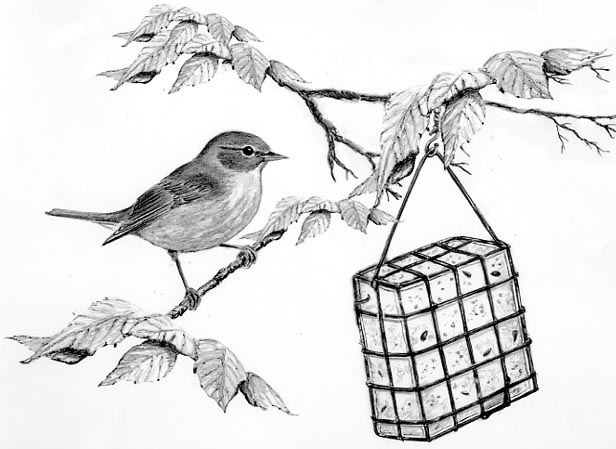
Dear Bird Folks,
We are pretty sure that we have an Orange-crowned Warbler coming and eating from our peanut butter tree. The question that I have is, where is the “orange crown” on the Orange-crowned Warbler? It isn’t visible at all and it’s not even mentioned in any of our bird books.
Thanks. -Beth, Chatham, MA
Wait a minute,
Beth, Did you really say that you have a “peanut butter tree”? A peanut butter tree? How cool is that? Your yard must smell great. When you rake up the leaves in the fall, do some of them get stuck to the roof of your mouth? And what about the squirrels? Wait. Forget about the squirrels. What about monkeys and elephants? They must be a huge problem. It’s a good thing you don’t have a jelly tree, too, or in addition to the elephants, you’d have a yard filled with elementary school kids looking for their favorite lunch. You don’t need that.
I’m with you, Beth. Sometimes I don’t know where they dig up these bird names. I’ve had to listen to tons of complaints about the apparent lack of red on the Red-bellied Woodpecker. Like that’s somehow my fault. On the other hand, nobody ever seems to question the lack of hair on the Hairy Woodpecker. Yet, Kojak had more hair than that bird does. And what about the Bobolink? I don’t even know where to begin with that name.
Sometimes common names are helpful in field identification, and other times not so much. This is one of those not-so-much times. In terms of actual field marks the Orange-crowned Warbler doesn’t have a lot going for it. In fact, many books tell us to use the “lack of field marks” to identify this bird. They claim that if you don’t see anything special on the bird it must be an orange-crown. That’s a lot of help. There are tons of birds that don’t look like anything special to me. But field marks aside, this warbler really does have a touch of orange on its head. Although, I really wouldn’t call it a “crown.” It is more of dusting, like the bird might get if it stuck its head into a bag of Cheetos.
Because of its blandness, many people aren’t familiar with this fairly common bird. During the breeding season orange-crowns can be found throughout many of our western states, including Alaska, and in much of Canada. Even though it’s a hardy bird, it’s not hardy enough to deal with those crazy Canadian winters. Come fall it moves to the southern U.S. states and to Mexico. Each winter a few of these tiny warblers try to save themselves some time and energy by coming to coastal Cape Cod. This is when we have our best chance of seeing them. I’m not sure if our local population of this bird is increasing or we are all just getting better at identifying them, but over the past few winters we have gotten several reports of Orange-crowned Warblers eating at suet feeders, or on peanut butter trees.
In addition to eating suet and peanut butter, orange-crowns are one of the few birds that have figured out that there is a treat waiting for them in a hummingbird feeder. Many people in the West report these birds being competition for the small but feisty hummers. In the tropics they continue to compete with hummingbirds. They aren’t agile enough to hover over the flowers like the hummers do, so instead they land on the base of the blossom, smack a hole in it with their bill and drink away. The clever orange-crowns have also learned to follow sapsuckers. After a sapsucker has drilled some holes in a nice juicy tree and has its fill of sap, this warbler will often move in and slurp up a bit for itself.
You have a good reason to be confused about this bird’s name, Beth. Even though the Orange-crowned Warbler technically has a trace of orange feathering on its head, it’s not really an accurate name for this rather generic, nondescript warbler. In fact, there once was a movement to change the bird’s name to the “Generic-nondescript Warbler,” but that notion was dropped when they became worried that the bird would be confused with Al Gore.
On another topic:
Back in December a nice lady from New Jersey wrote in about seeing an American Avocet. In her note she mentioned that the avocet was a “life bird” for her. Over the past few weeks I’ve had a whole host of people ask me what a life bird is. Even the newspaper called me about it. Like stamp collecting or Jell-O wrestling, bird watching is a hobby. For some people, part of the hobby is keeping a list of every species of bird they see in their life. When they see a brand new bird they include that bird in their lifelong list of birds, aka, their “life list.” Each new bird added to that list is known as a life bird. There you have it. I know it’s not very exciting, especially when compared to Jell-O wrestling, but keep in mind we are talking about bird watchers here.